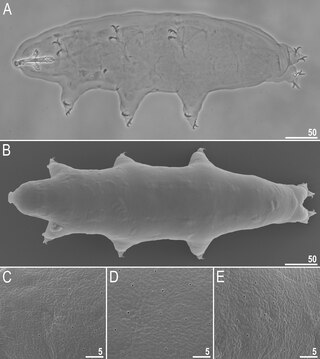
Lobopodians are members of the informal group Lobopodia, or the formally erected phylum Lobopoda Cavalier-Smith (1998). They are panarthropods with stubby legs called lobopods, a term which may also be used as a common name of this group as well. While the definition of lobopodians may differ between literatures, it usually refers to a group of soft-bodied, marine worm-like fossil panarthropods such as Aysheaia and Hallucigenia.

In botany, apomixis is asexual development of seed or embryo without fertilization. However, other definitions include replacement of the seed by a plantlet or replacement of the flower by bulbils.

Panarthropoda is a proposed animal clade containing the extant phyla Arthropoda, Tardigrada and Onychophora. Panarthropods also include extinct marine legged worms known as lobopodians ("Lobopodia"), a paraphyletic group where the last common ancestor and basal members (stem-group) of each extant panarthropod phylum are thought to have risen. However the term "Lobopodia" is sometimes expanded to include tardigrades and onychophorans as well.

Tardigrades, known colloquially as water bears or moss piglets, are a phylum of eight-legged segmented micro-animals. They were first described by the German zoologist Johann August Ephraim Goeze in 1773, who called them Kleiner Wasserbär. In 1777, the Italian biologist Lazzaro Spallanzani named them Tardigrada, which means "slow steppers".

Hypsibius dujardini sensu lato is a species complex of tardigrade in the class Eutardigrada. A member of this complex, Hypsibius exemplaris, is widely used for various research projects pertaining to evolutionary biology and astrobiology.

Echiniscus testudo is a cosmopolitan species of tardigrade.

Acutuncus is a genus of tardigrades containing a single species, Acutuncus antarcticus. Tardigrades, which are eight-legged micro-animals, are commonly referred to as water bears or moss piglets and are found all over the world in varying extreme habitats. First discovered in 1904 and originally named Hypsibius antarcticus, Acutuncus antarcticus is the most abundant tardigrade species in Antarctica.

Milnesium tardigradum is a cosmopolitan species of tardigrade that can be found in a diverse range of environments. It has also been found in the sea around Antarctica. M. tardigradum was described by Louis Michel François Doyère in 1840. It contains unidentified osmolytes that could potentially provide important information in the process of cryptobiosis.

Milnesium is a genus of tardigrades. It is rather common, being found in a wide variety of habitats across the world. It has a fossil record extending back to the Cretaceous, the oldest species found so far is known from Turonian stage deposits on the east coast of the United States. Milnesiums are one of the most desiccation and radiation-resistant invertebrates on Earth because of their unique ability to transform into a "tun" state and utilize intrinsically disordered proteins when experiencing extreme environments.

Richtersius is a monospecific genus of tardigrades in the family Richtersiidae; its sole species is Richtersius coronifer. R. coronifer is one of two species of tardigrade that have been shown to survive and continue reproducing after exposure to outer space, specifically in the thermosphere at 258–281 km above sea level with ionizing solar and galactic cosmic radiation for 10 days. However, unlike Milnesium tardigradum, R. coronifer did not survive under these conditions plus UV exposure.
Parthenogenesis is a mode of asexual reproduction in which offspring are produced by females without the genetic contribution of a male. Among all the sexual vertebrates, the only examples of true parthenogenesis, in which all-female populations reproduce without the involvement of males, are found in squamate reptiles. There are about 50 species of lizard and 1 species of snake that reproduce solely through parthenogenesis. It is unknown how many sexually reproducing species are also capable of parthenogenesis in the absence of males, but recent research has revealed that this ability is widespread among squamates.
Milnesium antarcticum is a species of Eutardigrades in the family Milnesiidae. This species differs from its cogenerate species mainly by proportions of its claws and buccopharyngeal apparatus.
Milnesium asiaticum is a species of Eutardigrades in the family Milnesiidae. This species differs from its cogenerate species mainly by proportions of its claws and buccopharyngeal apparatus.
Macrobiotidae is a family of tardigrade. As of 2023, it consists of the following genera:

Macrobiotus is a genus of tardigrade consisting of about 100 species.

Macrobiotus shonaicus is a species of tardigrade in the family Macrobiotidae. As of 2018 it is only known from its type locality: Tsuruoka, Japan. The species description was published in 2018. The insides of their first three pairs of legs have a slight fold above their claws, and their eggs have processes whose terminal discs split off into thin filaments.
Bertolanius is a genus of tardigrades belonging to the family Eohypsibiidae.
Echiniscus madonnae is a tardigrade species, genus of Echiniscus. It was described by Polish zoologists Michalczyk and Kaczmarek Łukasz in South America in 2006, and named in honor of American singer-songwriter Madonna.
Milnesium lagniappe is a species of Eutardigrade in the family Milnesiidae. It is found in the southeastern United States, where it grows on lichens and plant litter. This microscopic creature belongs to the Milnesium granulatum species complex and is characterised by its claw formula, distinct cuticle features and stout claws with well-developed accessory points.












